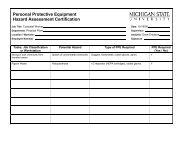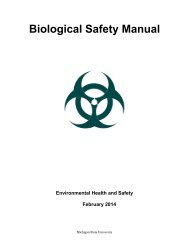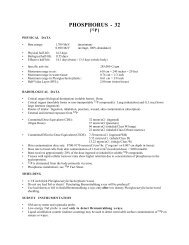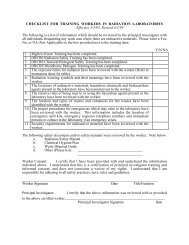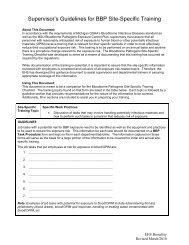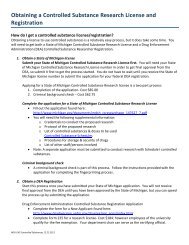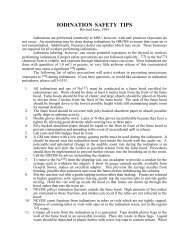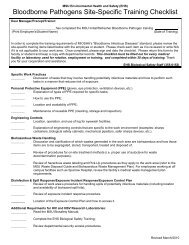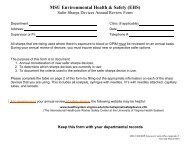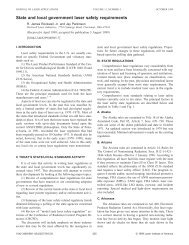employee hearing conservation program - the orcbs - Michigan ...
employee hearing conservation program - the orcbs - Michigan ...
employee hearing conservation program - the orcbs - Michigan ...
Create successful ePaper yourself
Turn your PDF publications into a flip-book with our unique Google optimized e-Paper software.
EMPLOYEE HEARING CONSERVATION PROGRAM<br />
MICHIGAN STATE UNIVERSITY<br />
Office of Radiation, Chemical and Biological Safety<br />
Department of Audiology and Speech Sciences<br />
MSU Occupational Health<br />
July 2, 2002<br />
BACKGROUND:<br />
The Federal Occupational Safety and Health Administration (OSHA) promulgated a noise standard in<br />
1974 and published a Hearing Conservation Amendment to this standard in 1983. The current<br />
<strong>Michigan</strong> requirements are based on regulations promulgated by <strong>the</strong> <strong>Michigan</strong> Occupational Safety<br />
and Health Administration (MIOSHA) on June 16, 1993 (R325.60101-R325.60128 and Appendices A-<br />
D).<br />
The OSHA standard provides worker protection against <strong>the</strong> effects of noise exposure when sound<br />
levels exceed a time-weighted average level of 85 decibels over an 8-hour workday, or for higher<br />
levels of noise exposure over shorter periods (see Table I). If noise monitoring identifies workers who<br />
are exposed to <strong>the</strong>se levels, <strong>the</strong> employer must institute a continuing, effective <strong>hearing</strong> <strong>conservation</strong><br />
<strong>program</strong>.<br />
TABLE 1 – Permissible Noise Exposures<br />
Duration per day,<br />
hours<br />
Sound level dBA,<br />
slow response<br />
8 90<br />
6 92<br />
4 95<br />
3 97<br />
2 100<br />
1-½ 102<br />
1 105<br />
½ 110<br />
¼ or less 115<br />
MSU's Hearing Conservation Program (HCP) consists of five distinct areas:<br />
Monitoring (MIOSHA Standards R325.60110)<br />
Noise analysis (a sound level survey) is conducted whenever:<br />
• <strong>the</strong>re is knowledge or a suspicion that noise levels exceed 85 dB (A weighted) on an 8-hour<br />
time-weighted-average (TWA), or<br />
• <strong>employee</strong>s have shorter periods of exposure to higher levels of noise (see Table I).<br />
1
A combination of noise dosimetry, integrated sound level meter field measures, and direct <strong>employee</strong><br />
noise exposure interviews will be implemented for a sensitive noise evaluation on campus in order to<br />
identify <strong>the</strong> <strong>employee</strong>s who need to be enrolled in <strong>the</strong> HCP.<br />
Fur<strong>the</strong>rmore, noise monitoring shall be repeated when any production, equipment or administrative<br />
changes occur which might alter <strong>the</strong> noise exposure of any <strong>employee</strong>.<br />
When levels that exceed 85db(A) TWA are found, all reasonable efforts will be made to use<br />
administrative and/or engineering controls to reduce exposure.<br />
Audiometric testing (MIOSHA Standards R325.60112 – R325.60120)<br />
Audiometric testing will be conducted on all <strong>employee</strong>s (without cost to <strong>the</strong> <strong>employee</strong>) who:<br />
• are exposed to levels which equal or exceed 85 dB (A) TWA, or<br />
• have shorter periods of exposure to higher levels of noise (see Table I).<br />
An initial baseline audiogram will be obtained and subsequent annual audiograms will be compared to<br />
<strong>the</strong> baseline to ascertain if a significant threshold shift has occurred.<br />
All baseline and annual testing will be performed by an audiologist or by an Audiology graduate<br />
student under <strong>the</strong> direct supervision of a certified audiologist. OSHA Amendment guidelines for<br />
testing procedures, equipment and calibration requirements will be followed.<br />
Hearing Protection (MIOSHA Standards R325.60121 – R325.60122)<br />
All <strong>employee</strong>s exposed to 85dB(A) TWA noise must have available <strong>hearing</strong> protectors. It is <strong>the</strong><br />
employer's responsibility to ensure such <strong>hearing</strong> protectors are worn by <strong>employee</strong>s:<br />
• whose noise exposure exceeds 90dB(A) TWA; or<br />
• whose exposure equals or exceeds 85dB(A) TWA and have not yet had a baseline evaluation;<br />
or<br />
• who have experienced a Standard Threshold Shift (STS)<br />
• who have shorter periods of exposure to higher levels of noise (see Table I).<br />
The adequacy of <strong>hearing</strong> protector attenuation shall be reevaluated whenever noise exposure increase.<br />
Employee Training Program (MIOSHA Standards R325.60123)<br />
An educational <strong>program</strong> will be instituted for all <strong>employee</strong>s:<br />
• whose noise exposure exceeds 85dB(A) TWA, or<br />
• who have shorter periods of exposure to higher levels of noise (see Table I).<br />
This <strong>program</strong> will cover specific topics outlined in <strong>the</strong> OSHA document and be repeated annually.<br />
These specific topics include <strong>the</strong> following:<br />
1. The effects of noise on <strong>hearing</strong>.<br />
2. The purpose of <strong>hearing</strong> protectors, <strong>the</strong> advantages, disadvantages, and attenuation of various<br />
types, and instructions on selection, fitting, use and care.<br />
3. The purpose of audiometric testing and an explanation of test procedures.<br />
2
Record Keeping (MIOSHA Standards R325.60125)<br />
This system requirement includes <strong>employee</strong> annual <strong>hearing</strong> test data (test documentation should<br />
include <strong>the</strong> date, place, test equipment serial number; date of calibration; and specific examiner<br />
certification information); <strong>employee</strong> damage risk category; annual certification of test room<br />
performance; annual electro-acoustic calibration of test instrumentation (both audiometers and noise<br />
measurement equipment), and daily biological calibration of audiometers.<br />
Adjustments or revisions to recorded <strong>hearing</strong> data are solely <strong>the</strong> responsibility of an audiologist or<br />
qualified physician; all hard copy documentation of <strong>hearing</strong> testing may serve as medico-legal<br />
evidence in cases of workman’s compensation.<br />
Records of exposure measurements and audiometric testing will be maintained.<br />
RESPONSIBILITIES:<br />
Based on <strong>the</strong> MIOSHA requirements as described above <strong>the</strong> following areas of responsibility are<br />
designated:<br />
1. The Office of Radiation, Chemical and Biological Safety (ORCBS):<br />
The ORCBS is responsible for <strong>the</strong> overall coordination and implementation of <strong>the</strong> HCP. This<br />
includes:<br />
• providing regulatory guidance and assistance in compliance with OSHA regulations.<br />
• coordinating efforts to reduce hazardous noise by engineering and/or administrative<br />
controls where feasible.<br />
• providing Unit Administrators with a copy of <strong>the</strong> Occupational Noise Standard, which<br />
is to be posted in <strong>the</strong> workplace as required by <strong>the</strong> standard.<br />
• conducting a comprehensive noise survey for identification of <strong>employee</strong>s to be included<br />
in <strong>the</strong> <strong>program</strong>. The ORCBS will follow <strong>the</strong> recommendation made by <strong>the</strong> National<br />
Institutes for Occupational Safety and Health (NIOSH) to conduct noise surveillance on<br />
<strong>employee</strong>s using noise dosimeter and integrated sound level meters in two-year<br />
intervals.<br />
• providing noise surveys on a requested or as needed basis;<br />
• provide an on-line annual training <strong>program</strong>, and<br />
• oversee a worker training database<br />
2. Department of Audiology and Speech Sciences (ASC):<br />
ASC is responsible for audiometric testing of <strong>employee</strong>s, and for record keeping and<br />
notification regarding <strong>the</strong>se tests. This includes:<br />
• completion of <strong>hearing</strong> evaluations on all <strong>employee</strong>s exposed to 85dBA noise levels for<br />
both baseline and annual testing;<br />
• <strong>hearing</strong> <strong>conservation</strong> consultations ei<strong>the</strong>r on an individual or group basis;<br />
• record keeping and notifications<br />
Record keeping includes sound level surveys, <strong>hearing</strong> test data, and required <strong>employee</strong> and<br />
employer notification. Results of testing will be provided to <strong>the</strong> <strong>employee</strong> and MSU’s<br />
Occupational Physician at Olin Health Center.<br />
3
ASC, along with <strong>the</strong> ORCBS is responsible for notifying <strong>the</strong> Unit Administrators of<br />
Departments with <strong>employee</strong>s who are currently in <strong>the</strong> HCP of <strong>the</strong> annual <strong>hearing</strong> test<br />
requirement. The Unit Administrator of those affected departments is responsible for<br />
delegating an individual within <strong>the</strong> department to act as a liaison with ASC in arranging testing<br />
and training with <strong>the</strong> <strong>employee</strong>'s unit.<br />
3. MSU Occupational Health:<br />
MSU Occupational Health is responsible for <strong>the</strong> maintenance of <strong>employee</strong> health records and<br />
will include <strong>hearing</strong> test data as it is received from ASC. MSU Occupational Health is also<br />
responsible for required MIOSHA notifications based on <strong>hearing</strong> loss as a reportable disease.<br />
MSU Occupational Health processes new <strong>employee</strong> physical examinations and is responsible<br />
for arranging baseline testing with ASC.<br />
4. Unit Administrator:<br />
The Unit Administrator is responsible for compliance with MSU's HCP within his/her area of<br />
responsibility. It is expected that each administrator will appoint a contact person to serve as a<br />
liaison with <strong>the</strong> ORCBS and ASC to coordinate sound level surveys, annual <strong>hearing</strong> testing and<br />
training efforts. The Unit must identify that appointed person for <strong>the</strong> ASC for ease of<br />
communication and scheduling. The Unit Administrator is also responsible for providing<br />
affected <strong>employee</strong>s or <strong>the</strong>ir representatives with access to a copy of <strong>the</strong> Occupational Noise<br />
Standard, as well as posting a copy in <strong>the</strong>ir workplace. Note that a copy of this standard is<br />
available through <strong>the</strong> ORCBS web site at www.<strong>orcbs</strong>.msu.edu.<br />
The unit must provide <strong>the</strong> ORCBS with a list of personnel who are exposed to hazardous noise<br />
areas (as identified by previous noise surveys). It is also each unit's responsibility to evaluate<br />
<strong>program</strong>s, processes and jobs and notify <strong>the</strong> ORCBS of possible noise hazards that require a<br />
survey.<br />
5. First line supervisors:<br />
It is <strong>the</strong> direct responsibility of an <strong>employee</strong>'s first line supervisor to ensure appropriate safety<br />
measures are followed. This includes enforcement of <strong>hearing</strong> protector use where required and<br />
accommodation with <strong>hearing</strong> test requirements.<br />
6. Employee:<br />
Safety is each individual's responsibility. Use of <strong>hearing</strong> protection where indicated is first and<br />
foremost <strong>the</strong> individual <strong>employee</strong>'s concern. It is also incumbent on each <strong>employee</strong> to appear<br />
for required <strong>hearing</strong> evaluations, follow instructions regarding noise exposure prior to testing<br />
and participate in annual training as directed.<br />
PROGRAM COSTS:<br />
The Department or Unit is responsible for costs related to services from Audiology and Speech and<br />
MSU Occupational Health.<br />
4



